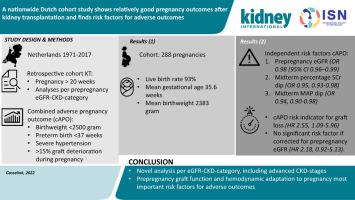Kidney International ( IF 14.8 ) Pub Date : 2022-06-28 , DOI: 10.1016/j.kint.2022.06.006 Margriet E Gosselink 1 , Marleen C van Buren 2 , Judith Kooiman 1 , Henk Groen 3 , Wessel Ganzevoort 4 , Henk W van Hamersvelt 5 , Olivier W H van der Heijden 6 , Jacqueline van de Wetering 2 , A Titia Lely 1

|
Although numbers of pregnancy after kidney transplantation (KT) are rising, high risks of adverse pregnancy outcomes (APO) remain. Though important for pre-conception counselling and pregnancy monitoring, analyses of pregnancy outcomes after KT per pre-pregnancy estimated glomerular filtration rate-chronic kidney disease (eGFR-CKD)-categories have not been performed on a large scale before. To do this, we conducted a Dutch nationwide cohort study of consecutive singleton pregnancies over 20 weeks of gestation after KT. Outcomes were analyzed per pre-pregnancy eGFR-CKD category and a composite APO (cAPO) was established including birth weight under 2500 gram, preterm birth under 37 weeks, third trimester severe hypertension (systolic blood pressure over 160 and/or diastolic blood pressure over 110 mm Hg) and/or over 15% increase in serum creatinine during pregnancy. Risk factors for cAPO were analyzed in a multilevel model after multiple imputation of missing predictor values. In total, 288 pregnancies in 192 women were included. Total live birth was 93%, mean gestational age 35.6 weeks and mean birth weight 2383 gram. Independent risk factors for cAPO were pre-pregnancy eGFR, midterm percentage serum creatinine dip and midterm mean arterial pressure dip; odds ratio 0.98 (95% confidence interval 0.96–0.99), 0.95 (0.93-0.98) and 0.94 (0.90-0.98), respectively. The cAPO was a risk indicator for graft loss (hazard ratio 2.55, 1.09-5.96) but no significant risk factor on its own when considering pre-pregnancy eGFR (2.18, 0.92-5.13). This was the largest and most comprehensive study of pregnancy outcomes after KT, including pregnancies in women with poor kidney function, to facilitate individualized pre-pregnancy counselling based on pre-pregnancy graft function. Overall obstetric outcomes are good. The risk of adverse outcomes is mainly dependent on pre-pregnancy graft function and hemodynamic adaptation to pregnancy.
中文翻译:

一项全国性的荷兰队列研究表明,肾移植后的妊娠结局相对较好,并发现了不良结局的危险因素
尽管肾移植 (KT) 后怀孕的人数在增加,但不良妊娠结局 (APO) 的高风险仍然存在。尽管对于孕前咨询和妊娠监测很重要,但之前尚未大规模地对每个孕前估计的肾小球滤过率-慢性肾脏病 (eGFR-CKD) 类别的 KT 后妊娠结局进行分析。为此,我们对 KT 后妊娠超过 20 周的连续单胎妊娠进行了一项荷兰全国队列研究。根据孕前 eGFR-CKD 类别分析结果,并建立复合 APO (cAPO),包括出生体重低于 2500 克、早产低于 37 周、妊娠晚期严重高血压(收缩压超过 160 和/或舒张压超过 110 mm Hg)和/或妊娠期间血清肌酐增加超过 15%。在对缺失的预测值进行多重插补后,在多级模型中分析了 cAPO 的风险因素。总共包括 192 名妇女的 288 次怀孕。总活产率为 93%,平均胎龄 35.6 周,平均出生体重 2383 克。cAPO 的独立危险因素是孕前 eGFR、中期血清肌酐百分比下降和中期平均动脉压下降;比值比分别为 0.98(95% 置信区间 0.96-0.99)、0.95 (0.93-0.98) 和 0.94 (0.90-0.98)。cAPO 是移植物丢失的风险指标(风险比 2.55,1.09-5.96),但在考虑孕前 eGFR(2.18,0.92-5.13)时,它本身并不是重要的风险因素。这是关于 KT 后妊娠结局的最大、最全面的研究,包括肾功能不佳女性的妊娠,以促进基于孕前移植物功能的个性化孕前咨询。总体产科结果良好。不良结局的风险主要取决于孕前移植物功能和对妊娠的血流动力学适应。










































 京公网安备 11010802027423号
京公网安备 11010802027423号